[QUOTE=aracer;1640660. There is no optimum position of the frame.[/QUOTE]
Then try riding with the frame in a horizontal position 
[QUOTE=aracer;1640660. There is no optimum position of the frame.[/QUOTE]
Then try riding with the frame in a horizontal position 
…which makes the frame/seatpost lean back; I’m pretty confident that 99% of the time the seatpost is leaning backward from vertical, except for the one millisecond before you upd.
But I could be wrong.
( little threadjack ) This is an interesting thread here guys
I have the adjustable seatpost on my 26" 29" and the seat is flat at the back.
Both posts lean back from vertical when I’m riding. ( or at least it feels that they do )
My 36" does not have an adjustable seatpost ( working on that, just can’t bring myself to take the hacksaw to it  ) and the seatpost is bolt upright. This causes my sit area to settle in the curve of the seat. I don’t find this as comfy as sitting at the back of the seat on the other uni’s.
) and the seatpost is bolt upright. This causes my sit area to settle in the curve of the seat. I don’t find this as comfy as sitting at the back of the seat on the other uni’s.
But, now it’s mentioned, I do have a sense of sitting ‘above the wheel’ on my 36", not behind it as on my other uni’s.
Could this be just the different size of wheel ?
My 20" seat is non adjustable but I’m never on it long enough to figure that one out 
Wonder then if it’s easier to learn on a seat that puts you above the wheel, or behind it. I know it’s only mm in some cases
Then again I may be talking tosh…
( I sometimes have to remember that “whatever is written on the internet…stays on the internet” 
Edit…yes, the more I think about it…I feel I’m sitting ‘on top’ of my 36", but ‘behind’ on the others…hum. I wonder if I would be a better unicyclist if I felt I was sitting ‘on top’ all my uni’s.
In which case “The unicycle is most balanced and therefore more stable when the frame and seat post are in the vertical position” makes no sense at all. The frame is an irrelevance - the only things which matter are your contact points, the frame simply exists to put these in the right location. My suggestion puts the contact points in exactly the same location as your platform.

You still seem to be struggling with the concept that a unicycle is not constrained in the fore/aft direction.
Its all about the contact points
This discussion reminds me of these funny cranks that where designed to eliminate the “dead spot”.
This is just another prove that the shape between the contact points is not relevant.
Maybe some people here want to give them a try;)
If only they had made an ISIS version… ![]()
I honestly can’t believe they actually made something like that before crowd funding. That is just the kind of stupid idea that people line up to back on Kickstarter.
Yep, Here they are…just remove chainring, adapt a rotor and be gone. No more deadspots, just smooth effortless freedom. ![]()
I love how they made them with the spiral going one direction at first, then switched to going the other way! How did they decide that one was better than the other? ![]()
@ Aracer… I’ve just been looking at your last diagram. The dictionary must be mistaken when it describes horizontal as being parallel to the ground. 
Your diagram doesn’t represent a standard frame & seat post in the leaning position where the body has to deal with the forces acting away from the hub.
At least you’ve come round to the idea of the saddle being positioned over the point of ground contact.
Seriously though, I think geometry is only one part of the equation. There are dynamics involved since there are so many moving parts.
Why is it so hard to ride a unicycle… because your body is constantly grappling with a variety of dynamics.
In practice I find riding a unicycle feels better when the frame and seat post are vertical rather than when slanted.
Well now I’m really confused - I’ve always advocated that, but thought you were suggesting something different.
This is true, and can be demonstrated by balancing a unicycle out in the open. That’s how I used to take pictures of unicycles back in the day (example below).
But it stops being true if you have a long handlebar out front, unless the seat is similarly located to the rear, to balance the weight. Your cool beam does this.
But the equation changes if a person sits on the uni. The person will tend to weigh 10-20x what the frame and seat weigh on their own. Depending on the relationship between saddle and handles, the rider’s body mass may tend to be to the rear of center, or to the front. At this point, the angle of the fork is essentially irrelevant. The combined mass of the rider plus fram/seat/handlebars must seek equilibrium above the wheel.
I’ve included a picture of an old Sociable Tandem bike. This one was from the 1890s, and looks ridiculous. Don’t both riders have to be really close to the same weight to ride such a thing? The answer is no. At that same event, I saw the owner of one of those riding it with his daughter, who appeared to be about ten years old. The frame merely tilted a few degrees toward her side, and didn’t appear to affect their ability to ride it with ease.
I like the simplicity of your wood beam to test riding positions. It makes me want a setup that has a little bit of “give” to it, to act as a suspension system. All a road uni needs is a little bit of travel, to take the edge off the bumps. That would be nice.
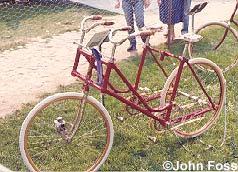
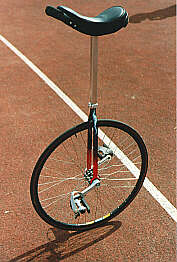
Thanks for the feedback, John.
I think there is always an element of correction while unicycling. I’m just attempting to minimize the amount of corrections the unicyclist has to make.
My thinking is that over a long distance, poor geometry or dynamics may cause the rider to repeat the same correction many thousands of times leading to premature tiredness and discomfort.
I reckon with the Sociable Tandem that the father had to make some extra correctional effort to compensate for the weight differential. Easy over a short distance, but over a longer distance of 30 miles for example, some part of his body would suffer duress.
As you know, with long distance road riding having the optimum set up is crucial for endurance.
I’ve decided to modify the saddle. I need to round the edges and I might put some cushioning on. I’m also going to experiment with saddle height which would mean riding in a more dropped position.
I’ll keep you all posted with my endeavors.
I think you should go do a 100 mile test… then tell us if that saddle is any better on your ass 
Hello Alan, I might put a bike saddle on as suggested by Muni123. I might even try fitting on the KH Zero saddle which would give me a higher saddle position allowing me to drop my shoulders into a more streamlined position. The advantage of the wooden saddle is that it weighs very little.
p.s. I’ve watched your video a few times and really enjoyed it. The music in it is a pleasure on the ears.
I use this saddle on my bike and I find it really comfy: http://www.spiderflex.com/
It might work with your set up??
Thanks for watching my video… its a really popular local band of fiddlers: http://www.blazinfiddles.com/
That Spiderflex is an interesting looking saddle, but for now I’ve decided to throw on a more standard grooved bike saddle. The wooden saddle was soo uncomfortable. I wooden’t get very far on it:p
I wooden’t get very far on it:p
I’ve also lengthened the the reach to the handle bars a bit more and have replaced the screws with bolts to ensure that the touring bar remains secured to the beam even after several upd’s.
I’ll try the new set during the week and see how it feels.
Oops I forgot the photo
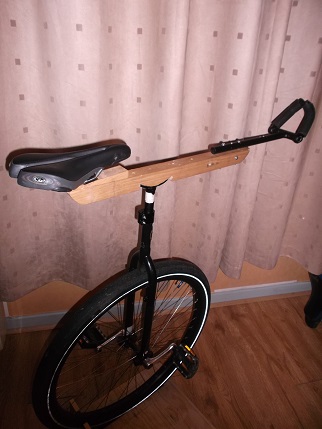
close ups of saddle arrangement
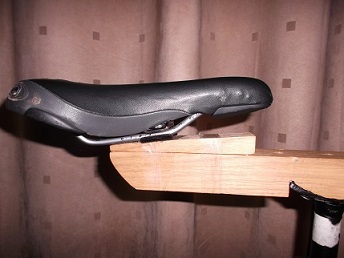
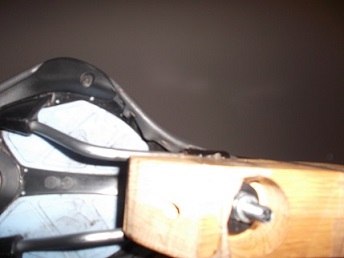
Aren’t you going to rub your thighs?